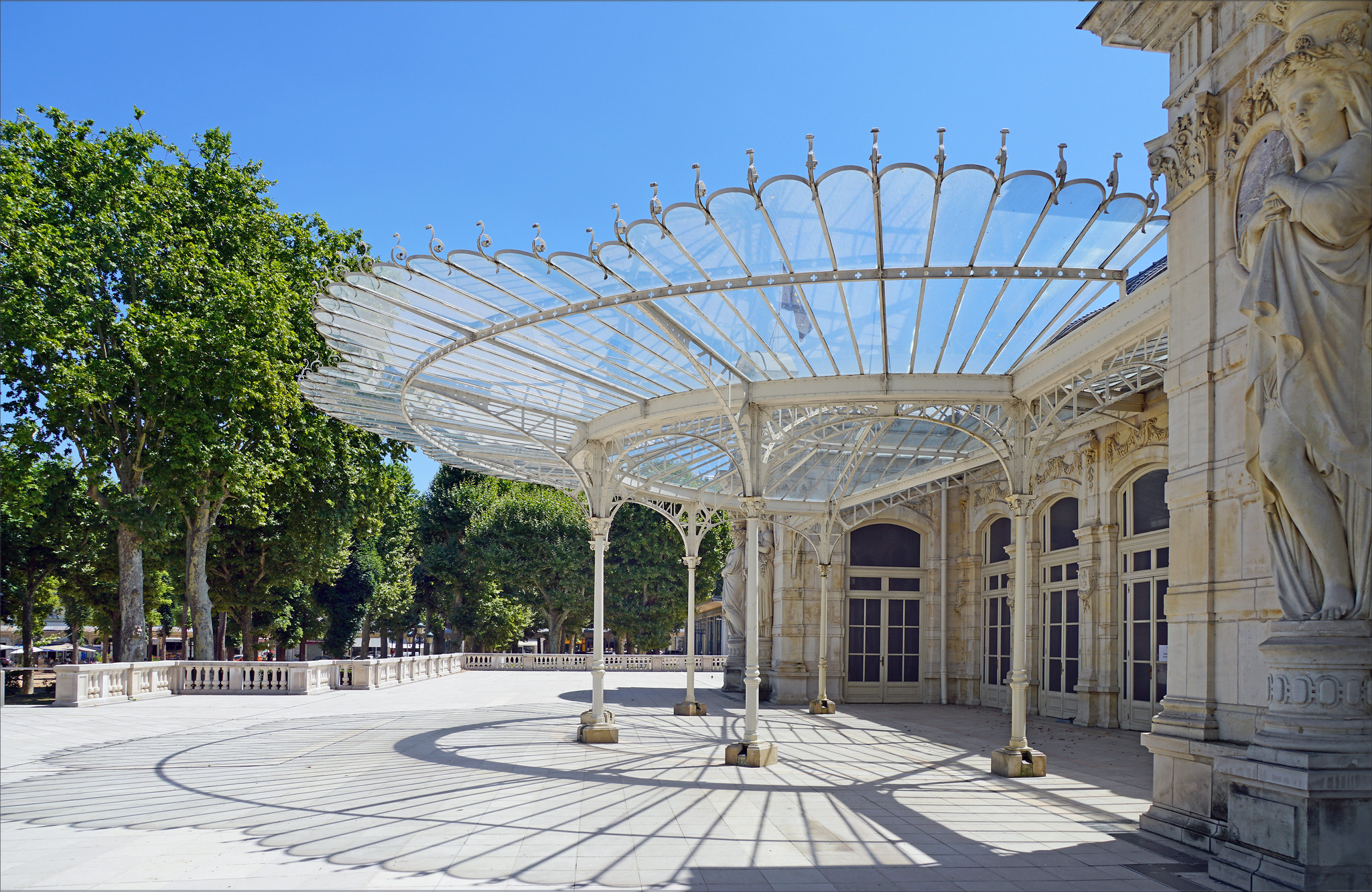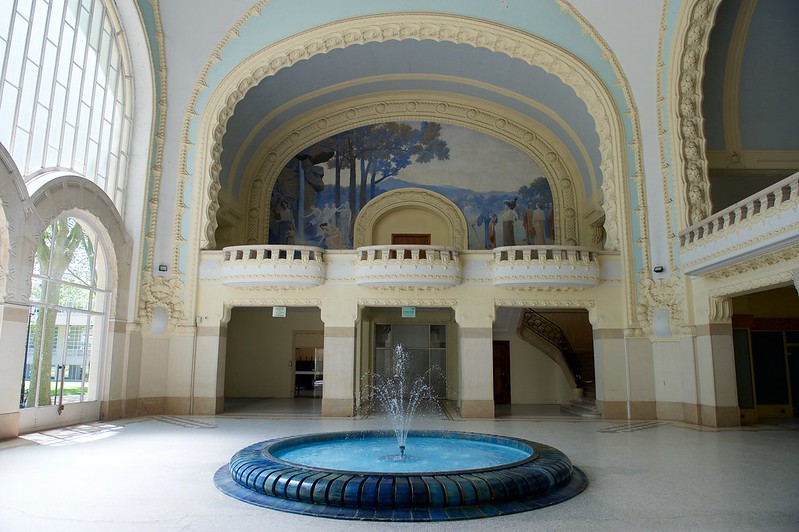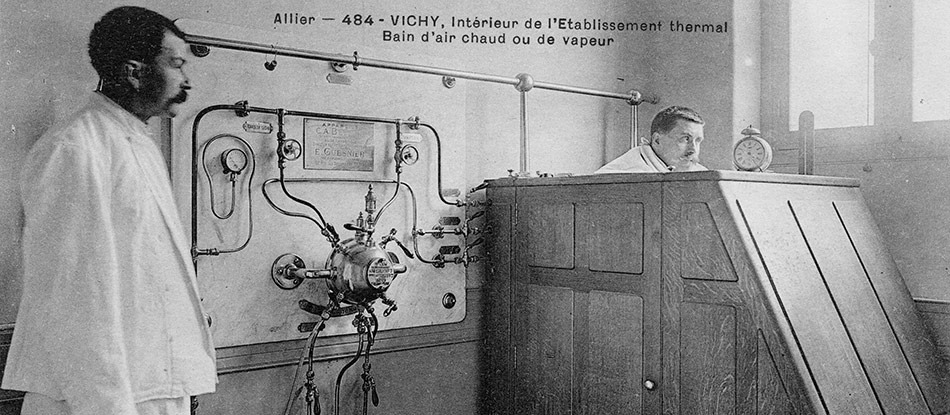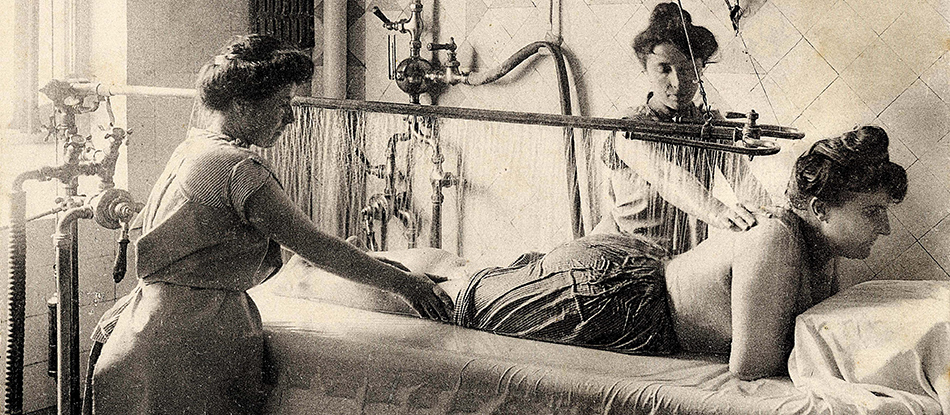For almost 2,000 years, people have drunk the water from France’s ‘Queen of Spas’ to cure their ills, but not so long ago the other treatments on offer were quite different from now.

Vichy’s Palais des Congrès (Photo: Jean-Pierre Dalbéra via Flickr / CC BY 2.0)
Drinking sulphurous water that tastes like rotten eggs, being pummelled under the jets of seven-headed showers, salt scrubs and even cryotherapy (a treatment which exposes the body to extreme cold for a short period of time): a spa experience at Vichy in the Auvergne region of central France is nothing if not varied.
For me, a spa is the perfect luxury. Were time and money no object, I’d get a daily massage, but I’ve tried some questionable treatments in my time: hot oil dripped rhythmically onto my forehead like slow torture, a floating salt bath in a dark room designed to mimic a womb, a bell rung with loud enthusiasm in my ear as I enjoyed a ‘relaxing’ shoulder massage. In comparison to treatments that have been offered in Vichy over the years, though, these are mainstream.

The grand Belle Époque stylings of a typical Vichy spa (Photo: Zenith via Flickr / CC BY 2.0)
People have been using mineral waters for healing since prehistoric times, and the birth of Vichy as a spa town can be traced back to 52 BC. Spas were already popular in Ancient Greece and Ancient Rome, and as the Romans expanded their empire west across modern day France, they came across the pungent, eggy mineral waters of Vichy.
But it would be some time before Vichy became a true spa resort. In 1605, King Henri IV of France created the General Superintendency for Spas and Mineral Fountains. Twenty-five years later, a small pavilion was constructed in Vichy where visitors could drink the water and bathe in it too, and the first of Vichy’s dietary regimes was introduced. Little by little, the wider public began to take an interest in the health benefits of the town’s waters.
During the 19th century, more and more people began to travel, both domestically and abroad. Travel had long been the preserve of aristocrats and a wealthy few, and while it was still only a minority that could afford the luxury of going on holiday, the arrival of the railroad put Vichy firmly on their map. Emperor Napoleon III was a particular fan of the town, visiting no fewer than five times between 1861 and 1866. Meanwhile, spa resorts were opening up across Germany, Belgium, the UK and France. Those who could afford it travelled to Aix-les-Bains, Évian-les-Bains, and of course, Vichy, for their health.

Old fashioned steam treatments (Photo: Courtesy of Vichy Celestines )
So what would did a visit to the Vichy spas of the past look like? Well, you wouldn’t have been eating salad for one thing, as Vichy forbade them, believing that they were acid-inducing. Instead, Vichy’s spas prescribed a diet of cheese and wine to their clientèle. And as spa-goers in Vichy washed down their bleu d’Auvergne with hearty quantities of Côtes du Rhône, were they receiving pedicures and hot stone massages? Not likely. In her book Tourists: How the British went Abroad to Find Themselves, Lucy Lethbridge writes “there were bone doctors, worm doctors, wind and water doctors.” Treatments on offer included “radioactive mud, sweat grottos, salles de pulvérisation, gas injections and percussion douches.” It may sound like a list of torture methods carried out by the Spanish Inquisition, but salles de pulvérisation and percussion douches actually combined pressured jets of water with massages, much like the ‘Vichy Shower’ still offered at resorts today. Treatments using radium, meanwhile, continued for several decades, with radioactive baths believed to cure respiratory illnesses and rheumatism, and even diminish wrinkles. Spa-goers would drink radium too, from specially designed ‘radium cafetières’.
While waiting for a rendezvous with the bone doctor, or recovering from your gas injections, you were welcome to take a bath in the communal dipping pools. “[They] were often described as ‘soupy’, resembling chicken broth [or] Mulligatawny”, writes Lethbridge of the murky water. Despite this, spas continued to grow in popularity and by 1893 France had just shy of 400 spas. Vichy itself grew in size, from a population of 1,500 in 1850 to 15,000 by 1914.
In 1896, the Vichy Shower was perfected. The Belle Époque was in full swing. Guests would be massaged under the seven heads of a specially designed shower, designed to represent Vichy’s mineral springs (never mind that there are actually nine). In 1903, the Grand Établissement Thermal opened its doors. More than a century on, it’s still in operation. Water from Vichy was said to cure rheumatism, arthritis, and even liver disease. Although mineral water may not be lauded to have quite such magical healing powers today, it is still thought to aid bone and heart health, and to lower cholesterol.
Visitors to Vichy at the turn of the 20th century may even have been lucky enough to have their eggy water served by a young girl who would go on to become one of the most influential fashion designers the world has ever seen. Gabrielle Chanel, or Coco, as she would later become known, worked as a donneuse d’eau (water girl) in Vichy in 1906.

The Vichy shower (Photo: Courtesy of Vichy Celestines)
In 1947 the French government introduced social thermalism, meaning that spa treatments could be reimbursed using social security. The full thermal cure lasted 21 days. Interest in Vichy’s healing waters was revived. Even today, French citizens can claim the cost of their spa treatments, if prescribed by a doctor.
Vichy spas nowadays, however, are a more comfortable experience. Ushered into a clean, white reception area, you’ll be confronted with rows of Vichy laboratories skincare products, neatly packaged in blue, the signature V logo in white. You’ll be presented with a fluffy white bathrobe, and a chilled glass of Vichy Célestins water (mercifully, not tasting like gone-off eggs). If you’re anything like me, you’ll be so swept up in the atmosphere of wellness and detoxing, that for a brief time you’ll regard your body as the holiest of temples and nourish it solely with salads and fresh fruit.
Vichy Célestins Spa Hôtel still offers Vichy showers, but gone are the days of wallowing in radioactive mud, although mineral mud is still used as a body wrap at Thermes des Dômes and Thermes Callou. There are plenty of vegetables on the restaurant menus too, so those hoping to be prescribed an exclusively wine and cheese diet are sadly out of luck.